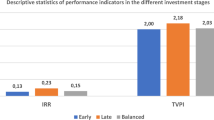Abstract
We develop a valuation model that integrates corporate capital structure and dividend payout policies. The resulting “extended” Miller (J Financ 32:261–297, 1977) model explicitly incorporates the different tax rates on corporate income, personal interest, dividends, and capital gains. We apply the model to ten different U.S. tax regimes since 1979 and generate several testable predictions. When the dividend tax rate exceeds the capital gains tax rate, dividend payout can partially offset value-enhancing effects of leverage. When the two rates are close, dividend payout loses its moderating influence. Using the S&P 1500 universe, we obtain empirical results that are consistent with the model’s predictions.








Similar content being viewed by others
Notes
τ c : Corporate tax rate; τ s : Personal tax rate on equity income; τ d : Personal tax rate on interest income.
See the Appendix for the intermediate steps.
Note that the after-tax perpetual interest payments discounted by the required rate of return for the riskiness of the firm debt equals the market value of the debt D. The assumptions necessary for this derivation are the same as those in the original MM analyses.
We assume a symbolic value of $1.00 for a non-dividend-paying all-equity firm. The gain from leverage and loss from payout emerge as a percentage of this $1.00 baseline value as a function of the four tax rates.
The slopes of the sides of the wedges in Fig. 2 are smaller for the low payout firms (toward the higher side) than for high payout firms (toward the lower side).
References
Auerbach A, Hassett K (2006) Dividend taxes and firm valuation: New evidence. American Economic Review, May, pp 119–123
Auerbach A, Hassett K (2007) The 2003 dividend tax cuts and the value of the firm: An event study. In: Auerbach A, Hines J, Slemrod J (eds) Taxing corporate income in the 21st Century, pp 93–126
Brav A, Graham JR, Harvey CR, Michaely R (2005) Payout policy in the 21st century. J Financ Econ 77:483–528
Chang R, Rhee G (1990) The impact of personal taxes on corporate dividend policy and capital structure decisions. Financ Manage 19:21–32
DeAngelo H, DeAngelo L (2006) The irrelevance of the MM dividend irrelevance theorem. J Financ Econ 79:293–316
DeAngelo H, Masulis RW (1980) Optimal capital structure under corporate and personal taxation. J Financ Econ 8:3–29
DeAngelo H, DeAngelo L, Skinner DJ (2004) Are dividends disappearing? Dividend concentration and the consolidation of earnings. J Financ Econ 72:425–456
DeAngelo H, DeAngelo L, Stulz RM (2006) Dividend policy and the earned/contributed capital mix: a test of the life-cycle theory. J Financ Econ 81:227–254
Denis DJ, Osobov I (2008) Why do firms pay dividends? International evidence on the determinants of dividend policy. J Financ Econ 89:62–82
Fama EF, French KR (2001) Disappearing dividends: changing firm characteristics or propensity to pay? J Financ Econ 60:3–42
Graham JR (1996) Debt and the marginal tax rate. J Financ Econ 41:41–73
Graham JR, Tucker AL (2006) Tax shelters and corporate debt policy. J Financ Econ 81:563–594
Harris M, Raviv A (1991) The theory of capital structure. J Financ 46:297–355
Haugen RA, Senbet LW (1986) Corporate finance and taxes: a review. Financ Manage 15:5–21
Howton S, Howton S (2006) The corporate response to the 2003 dividend tax cut. Journal of Applied Finance, Spring/summer, 62–71
Jensen MC (1986) The agency costs of free cash flow: corporate finance and takeovers. Amer Econ Rev 76:323–329
Jensen MC, Meckling WH (1976) Theory of the firm: managerial behavior, agency costs and ownership structure. J Financ Econ 3:305–360
Li W, Lie E (2006) Dividend changes and catering incentives. J Financ Econ 80:293–308
Masulis RW (1980) The effect of capital structure change on security prices: a study of exchange offers. J Financ Econ 8:139–178
Miller M (1977) Debt and taxes: presidential address of annual meeting of American finance association. J Financ 32:261–297
Miller M, Modigliani F (1961) Dividend policy, growth and the valuation of shares. J Bus 34:411–433
Miller M, Scholes M (1978) Dividends and taxes. J Financ Econ 333–364
Modigliani F, Miller M (1958) The cost of capital, corporation finance and the theory of investment. Am Econ Rev 48:261–297
Modigliani F, Miller M (1963) Corporate income taxes and the cost of capital: a correction. Am Econ Rev 53:433–443
Myers S, Majluf NS (1984) Corporate financing and investment decisions when firms have information that investors do not have. J Financ Econ 13:187–221
Rogers R, Owers JE (1985) Equity for debt exchanges and stockholder wealth. Financ Manage 14:18–26
Author information
Authors and Affiliations
Corresponding author
Additional information
The paper benefited greatly from detailed insights and comments generously provided by the late Franco Modigliani. Comments by an anonymous reviewer improved the paper significantly. We gratefully acknowledge input by colleagues and research support from University of Washington, Bothell and Georgia State University, Robinson College of Business. Karel Vandromme and Leng Ling provided excellent research assistance. The usual disclaimer applies.
An erratum to this article can be found at http://dx.doi.org/10.1007/s12197-012-9225-z.
Appendix
Appendix
By cross-multiplying the middle term,
and combining the first and the third terms of the new expression, we have
Now, by taking the rD term from the second term and combining it with the third term,
and by taking \( \left( {1 - \tau_{pi} } \right) \) outside of the third term and rearranging,
Rights and permissions
About this article
Cite this article
Ince, U., Owers, J.E. The interaction of corporate dividend policy and capital structure decisions under differential tax regimes. J Econ Finan 36, 33–57 (2012). https://doi.org/10.1007/s12197-009-9101-7
Received:
Accepted:
Published:
Issue Date:
DOI: https://doi.org/10.1007/s12197-009-9101-7




